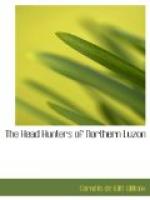On our way back to the shack in which some of us were to sleep (the school-house it was) we noticed an admiring crowd standing around the pony, tethered under the house, and all unconscious of the admiration he was exciting, most rudely presenting his hind-quarters to his admirers. But that was not his intention; the crowd—half women, by the way—wanted to be as close to the tail as possible. We left them gesticulating and pointing and commenting, much as our own women might while looking at crown jewels, but not so hopelessly; for the next morning, when we next saw the pony, nearly all the hair had been pulled out of his tail, except a few patches or tufts here or there, tougher than the rest, and serving now merely to show what the original dimensions must have been.
While we were undressing in came a little maiden, who marched up to every one of us, shook hands, and said, “Good evening, sir.” We were pretty well undressed, but our lack of clothes looked perfectly natural to her, perhaps inspired her with confidence. She said her name was Banda, that she was thirteen, but of this she could not know, as all these children had had ages assigned to them when they entered the school; after greeting us all, and airing her slight stock of English, she withdrew as properly as she had entered. A trifling incident, perhaps not worth recording, but in reality significant, for it marked confidence, especially as she had come in of her own accord. We all agreed that she was very pretty.
CHAPTER VIII
Appearance of the Ilongots.—Dress.—Issue
of beads and
cloth.—Warrior
dance.—School work.—Absence of
old women
from meeting.
The next morning we turned out early, and got our first real “look-see.” Campote is completely surrounded by mountains, the hogback dropping off into the valley below us. About four or five hundred people had assembled, men, women, and children. As a rule, they were small and well built, but not so well built as the tribes farther north. The men were fully armed with spears, bows and arrows, shields, and head-knives; gee-strings apart, they were naked. Some of them wore on the head the scarlet beak of the hornbill; these had taken heads. Quite a number, both men and women, had a small cross-like pattern tattooed on the forehead; the significance of this I did not learn. The shield is in one piece, in longitudinal cross-section like a very wide flat V open toward the bearer, the top terminating in a piece rising between two scoops, one on each side of the median line. The women had on short skirts and little jackets (like what, I am told, we call bolero jackets), the bosom being bare. Around the waist they wore bands of brass wire or of bamboo stained red and wound around with fine brass wire. These bamboo bands were pretty and artistic. You saw the children as they happened to be; the only thing to note about them being that they were quite




